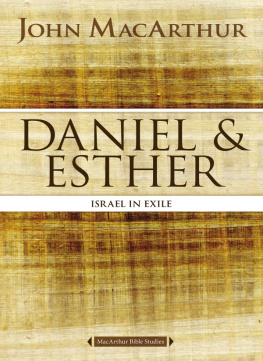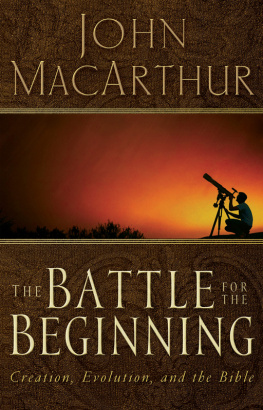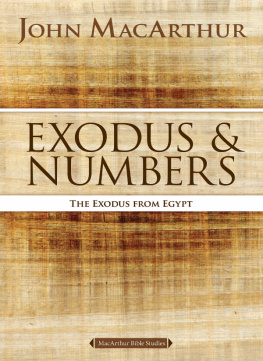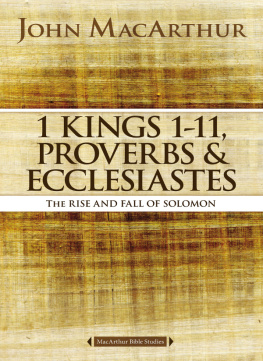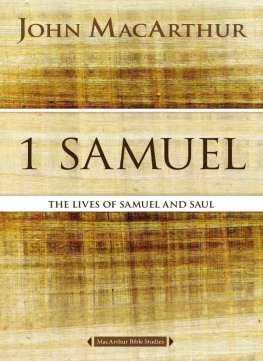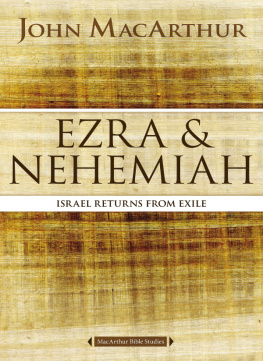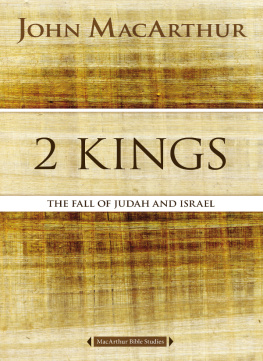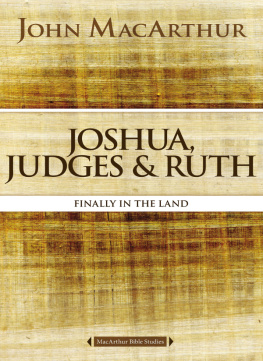
MacArthur Bible Studies
Daniel & Esther: Israel in Exile
2016 by John MacArthur
All rights reserved. No portion of this book may be reproduced, stored in a retrieval system, or transmitted in any form or by any meanselectronic, mechanical, photocopy, recording, scanning, or otherexcept for brief quotations in critical reviews or articles, without the prior written permission of the publisher.
Published in Nashville, Tennessee, by Nelson Books, an imprint of Thomas Nelson. Nelson Books and Thomas Nelson are registered trademarks of HarperCollins Christian Publishing, Inc.
Originally published in association with the literary agency of Wolgemuth & Associates, Inc. Original layout, design, and writing assistance by Gregory C. Benoit Publishing, Old Mystic, CT.
Unleashing Gods Truth, One Verse at a Time is a trademark of Grace to You. All rights reserved.
Thomas Nelson titles may be purchased in bulk for educational, business, fundraising, or sales promotional use. For information, please e-mail SpecialMarkets@ThomasNelson.com.
Scripture quotations are taken from The New King James Version. 1982 by Thomas Nelson. Used by permission. All rights reserved.
Some material from the Introduction, Keys to the Text and Exploring the Meaning sections taken from The MacArthur Bible Commentary, John MacArthur, Copyright 2005 Thomas Nelson Publishers.
ISBN 978-07180-3-4788
ISBN 978-07180-3-4917 (eBook)
First Printing April 2016
In this ebook edition, please use your devices note-taking function to record your thoughts wherever you see the bracketed instructions [Your Notes] or [Your Response Here]. Use your devices highlighting function to record your response whenever you are asked to checkmark, circle, underline, or otherwise indicate your answer(s).
CONTENTS
I n 605 BC, the Babylonians defeated the army of Egypt at the Battle of Carchemish and became the strongest nation in the ancient Near East. Due to this victory, all of Egypts vassals, including the small kingdom of Judah, became vassals of Babylon. The Babylonians followed up this great victory at Carchemish by invading the land of Judah that same year. After conquering the nation, they began to carry some of the nations ruling elite into captivity in Babylon.
Among the young men who were taken was a man named Daniel, who, along with three close friends, found himself serving in the courts of the Babylonian King Nebuchadnezzar. Daniel rose to prominence in Babylon and lived a long life faithfully serving a succession of kings in two different empires. Years later, around 486 BC, a king named Ahasuerus (also known as Xerxes) came to power in Persia, and he took for his wife a young Jewish woman named Esther.
While the experiences of these two Jews were very different, they both faced dangerous situations that threatened their lives because of their faith in God. They held fast to their beliefs, put their complete trust in the Lord, and witnessed His mighty hand at work not only in their lives but also in the lives of their people. In this way, both Daniel and Esther learned the vital lesson that God is sovereign and faithful to those who call on His name.
In these twelve studies, we will examine the lives of these remarkable individuals and witness the bold actions they took in the face of daunting circumstances. We will see how both Daniel and Esther made the critical choice of standing up for God and the people of Israel even when their lives were at stake. We will also look at some of the insidious characters who sought to destroy them and follow the rise and fall of empires and kings in the region.
Through it all, we will learn some precious truths about the character of God, and we will see His great faithfulness in keeping His promises. We will learn, in short, what it means to follow God wholeheartedly and walk by faith in him.
THE BOOK OF DANIEL
The book of Daniel bridges the entire seventy years of the Babylonian captivity from 605 BC to 536 BC. In nine of the twelve chapters, the prophet provides revelation from God through various dreams and visions. Daniel was Gods mouthpiece to the Gentile and Jewish world who declared Gods present and future plans.
AUTHOR AND DATE
Several verses in the book identify the writer as Daniel, whose name means God is my Judge. Daniel was taken captive from his noble family in Judah, deported to Babylon, and assimilated into Babylonian culture for the task of assisting with the imported Jews. There he quickly rose to the role of statesman by royal appointment and served as a confidante of kings, as well as a prophet, in two world empires.
Daniel spent the remainder of his long life (eighty-five years or more) in that city, living beyond the time he described in Daniel 10:1 (c. 536 BC). It seems most probable that he wrote the book shortly after this date but before c. 530 BC. Daniel 2:47:28, which prophetically describes the course of Gentile world history, was originally (and appropriately) written in Aramaic, the contemporary language of international business. Ezekiel, Habakkuk, Jeremiah, and Zephaniah were Daniels prophetic contemporaries.
BACKGROUND AND SETTING
The idolatry of the northern kingdom of Israel led to its downfall in 722 BC to the Assyrian Empire. When Assyrian power ebbed by 625 BC, the Neo-Babylonians conquered Assyria (along with its capital, Nineveh) in 612 BC, Egypt in the following years, and Judah in 605 BC. The long-continued sin of Judah, without national repentance, led to this judgment from God, for which Jeremiah, Habakkuk, and Zephaniah had given warning. Earlier, Isaiah and other faithful prophets of God had also sounded the alarm.
Daniel was among one of the first groups of deportees taken to Babylon in 605 BC. After he was transported there, the victors conquered Jerusalem in two additional stages (597 BC and 586 BC). In both takeovers, they deported more Jewish captives (Ezekiel was deported during the second takeover in 597 BC). The book thus begins in 605 BC with the exile of Daniel and his three friends, continues to the eventual demise of Babylonian supremacy in 539 BC (when the Medo-Persians conquered Babylon), and goes beyond to 536 BC.
HISTORICAL AND THEOLOGICAL THEMES
Daniel was written to encourage the exiled Jews by revealing Gods program for them, both during and after the time of Gentile power in the world. Prominent above every other theme in the book is Gods sovereign control over the affairs of all rulers and nations and their final replacement with the true King. God had not suffered defeat in allowing Judahs fall but was working His sure purposes toward an eventual, full revelation of His King, the exalted Christ.
A key aspect within the main theme of Gods kingly control is the Messiahs future coming in glory to rule the world over all people. He is like a stone in Daniel 2 and like a son of man in Daniel 7. In addition, He is the Anointed One (Messiah) in 9:26. Daniel 9 provides the chronological framework from Daniels time to Christs kingdom.
A second theme is the display of Gods sovereign power through miracles. Daniels era is one of six in the Bible with a major focus on miracles by which God accomplished His purposes. God, who has everlasting dominion and the ability to work according to His will, is capable of miracles, all of which would be lesser displays of power than was exhibited when He acted as Creator in Genesis 1:1.
Daniel chronicles the God-enabled recounting and interpreting of dreams that the Lord used to reveal His will. Other miracles include: (1) His protection of the three men in a blazing furnace (see Daniel 3); (2) His writing on the wall and Daniels interpretation of it (see Daniel 5); (3) His provision of safety for Daniel in a lions den (see Daniel 6); and (4) supernatural prophecies (see Daniel 2; 7; 8; 9:2412:13).
Next page
